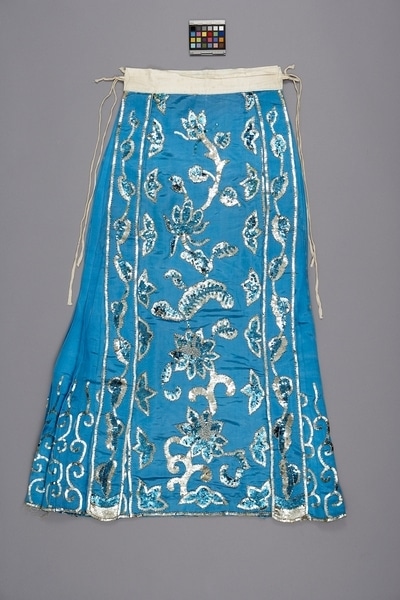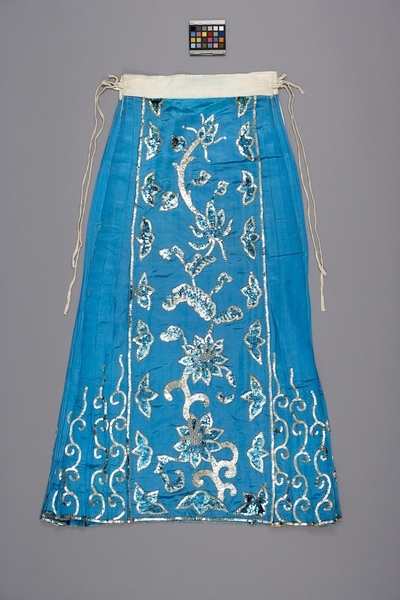Cantonese Opera Skirt Item Number: 2701/2 b from the MOA: University of British Columbia


Description
A skirt of shiny blue-green fabric decorated with sequins of darker blue-green and silver in a pattern of lotus flowers, stems, and leaves. It has two narrow front panels outlined in sequins that hang from a white cotton waist band with v-openings and ties at each side. The remainder of the skirt is pleated, and has a simpler sequin design along the bottom. The skirt is worn with a blouse (2701/2 a) as a costume.
History Of Use
This costume would have been worn by an actress representing a young woman of the early Republican period in Chinese history (c. 1911). Although men played female roles in the early 20th century, by the 1960s female roles were played only by women, with the occasional exception of role types representing old women. During the years 1900-1930, Cantonese opera costumes were decorated with silver-plated brass discs and then with round mirrors, together with gold and silver thread. Sequins made of gelatin were first used on Cantonese opera costumes in the 1930s. Heavily-sequined costumes were popular in the 1950s-60s, with the sequins then being made of plastic. Sequins have continued to come and go in popularity since that time.
Cultural Context
Cantonese Opera Performance
Iconographic Meaning
The historic period represented is indicated by the fitted shape of the blouse, its curved lower edge, and its high collar.
Item History
- Made in Hong Kong, China between 1960 and 1970
- Collected in Vancouver, British Columbia, Canada
- Owned by Ngai Lum Musical Society before April 21, 2008
- Received from Ngai Lum Musical Society (Donor) on April 21, 2008
What
- Name
- Cantonese Opera Skirt
- Identification Number
- 2701/2 b
- Type of Item
- skirt
- Material
- synthetic fibre ?, cotton fibre ?, plastic, dye and metal
- Manufacturing Technique
- cut and sewn
- Overall
- height 101.5 cm, width 68.0 cm
Who
- Culture
- Chinese: Cantonese
- Previous Owner
- Ngai Lum Musical Society
- Received from
- Ngai Lum Musical Society (Donor)
Where
- Holding Institution
- MOA: University of British Columbia
- Made in
- Hong Kong, China
- Collected in
- Vancouver, British Columbia, Canada
When
- Creation Date
- between 1960 and 1970
- Ownership Date
- before April 21, 2008
- Acquisition Date
- on April 21, 2008
Other
- Item Classes
- textiles
- Condition
- fair
- Accession Number
- 2701/0002 b